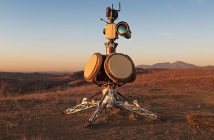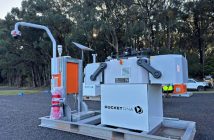
After years of circling the technology and regulatory stars are aligning for wide-scale drone use to take off in 2023 – with passenger and not just pizza deliveries on the horizon.
Elsight is now starting trials in the futuristic Israel National Drone Initiative, which has the goal of flying heavy cargo and passengers to reduce road congestion.
Given Elsight’s strong Australian links and contracts with major drone delivery providers internationally, learnings from the trials could also be applied to the plans for electric air taxis to be operating in Brisbane by the 2032 Olympics.
Flights Beyond Visual Line of Sight (BVLOS)
Elsight’s Halo drone connectivity platform for BVLOS drone operations has won the company contracts with leading drone delivery companies DroneUp, Air Methods’ wholly owned drone subsidiary, Spright and Speedbird in Brazil.
DroneUp supports US retail giant Walmart’s expanding drone delivery service, while Spright solves some of the toughest time sensitive challenges facing health services in the US.
Regulations catch up with tech
Leaders in the Australian drone industry are confident 2023 is the year we’ll start to see drones disrupting crewed aircraft.
What’s propelling the lift-off of drones is the alignment of cutting-edge BVLOS tech with the streamlining of approvals for its industrial and commercial uses.
BVLOS refers to operations where the operator of the drone can’t physically see the device during some or even all of its flight, even across hundreds of kilometres.
Dario Valenza, founder and CTO of leading Australian drone manufacturer Carbonix, says: “Without BVLOS drones are on a leash”.
Mr Valenza said the catalyst for more BVLOS approvals came late last year when the Federal Department of Infrastructure gave the Civil Aviation Safety Authority (CASA) more discretion on drones.
CASA is now using this discretion to be proactive in streamlining electronic approvals for potentially life-saving and lifestyle-changing applications.
These range from shark surveillance, bushfire and flood management to remote healthcare deliveries, urban grocery drop-offs and even verifying corporate carbon offset statements.
Elsight CEO Yoav Amitai says: “It is not a question of if anymore, but a question of when and how fast, and being a major part of it is a great feeling.
“We’ve only started to scratch the surface with the use cases that will be enabled by this infrastructure, including delivering to remote or hard to get locations.” he said.
“The commercial drone sector is like the internet in the ‘90s, when we saw it move from national security to facilitating everyday life across the whole of society.”
Lifesavers at beaches
For the first time, CASA has approved BVLOS surveillance trials over Sydney beaches as part of the New South Wales Government’s more than A$85 million in shark mitigation measures over the next couple of years.
The trials will expand on the use of drones operated within visual line of sight by Surf Life Saving NSW.
Groceries on the fly
In the US commercial drone delivery has become a reality as retail giant Walmart expands its drone delivery operations to 36 hubs across six states with support from DroneUp.
Google-owner Alphabet’s Wing unit has deployed delivery drones to hundreds of thousands of homes in Australia, Finland and Texas, and this month predicted millions more will be within range of drone deliveries in 2023.
In Australia Wing operates through its partnership with Coles from Canberra, Brisbane and the Gold Coast.
Emergency relief
In South Australia, a state reeling from devastating floods, Carbonix has partnered with electricity distributor SA Power Networks to conduct BVLOS aerial inspection on remote electricity lines and other assets across its 180,000km2 footprint.
Mr Valenza said the drones provided a clear alternative where it would not be safe to fly helicopters.
“During the floods, drones have prevented ground crews being sent out into dangerous weather to check whether the power needs to be cut off in flood-damaged areas,” he said.
“They’re also up to 80% cheaper to operate and emit 98% less CO2 than crewed aircraft, making drone use an easy win in cutting greenhouse emissions.
The drones also will speed up the utility provider’s asset inspection for bushfire preparedness and maintenance work, ultimately improving safety for the SA Power Network’s customers, 30% of whom are in remote areas.
Drones are also improving healthcare in regional Australia, with Swoop Aero awarded $1.8m in federal funding to expand operations that include transporting medical samples from remote locations to pathology labs.
Counting carbon offsets
Drones are increasingly being used as a vital tool in holding large companies to account on carbon emissions.
Tom Caska, CEO and co-founder of ‘Uber for drones’ company Aerologix says: They are used for above-ground, granular carbon calculations that satellites cannot do because the analysis must be so granular.
“This isn’t about just getting cool images, it’s about ensuring transparency in corporate ESG statements.”
Mr Caska also notes that in Australia, with its huge distances, the use of drones instead of crewed aircraft provides an easy solution in terms of cutting emissions.
What’s next?
Mr Valenza says the next disruptive event in the drone sector will come when regulations allow for “one to many” BVLOS operations.
“That’s when a remote operator can control numerous drones at the same time, leading to remote operations at scale.”
With more drones sharing the sky, other aircraft safety is a key priority and that’s where Elsight’s Halo comes in.
Joe Resnick, president Spright, which delivers healthcare supplies by drone to some of the most difficult to reach communities in the US, says: “Halo leverages four major cellular networks, as well as satellites, to allow for safe and secure BVLOS drone operations.
“With the implementation of this solution on our aircraft, Spright is now becoming a safer and more efficient autonomous solution for the pick-up and delivery of healthcare goods.
“Safety and mission continuity are key for Spright, and for the industry as a whole as well as regulators, which is why we chose Elsight as the best solution to fit those needs.”






